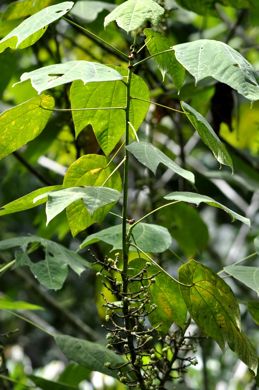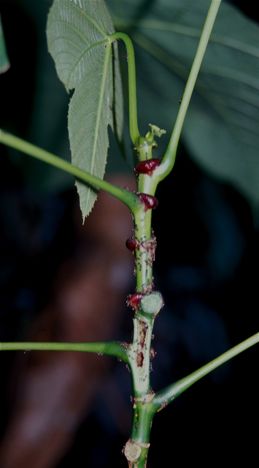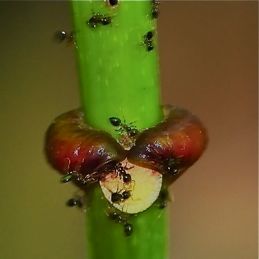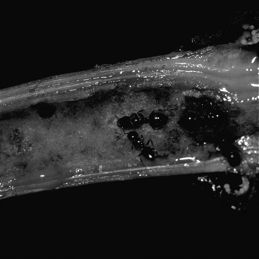The common mahang (Macaranga bancana) is a small to medium sized tree that grows up to 20 metres high (above left). The large leaves are characteristically three-lobed. At the base of each leaf stalk is a pair of dark purple stipules, on the undersurface of which are many white starch grains (above right, below left). These starch grains attract ants of the genus Crematogaster that bore into the hollow twigs and nest inside (below right). The ants bring in mealybugs into the hollow stem and regularly “milk” them for their sweet secretions. As repayment for shelter, the ants protect the plant from herbivores. Should you touch the stem tip, ants will emerge from inside the hollow stem through the tiny opening (below left, opening at top) to confront you.
The plant bears male and female flowers in different trees. Fruits are leathery shouldered capsules splitting into two-valved parts exposing black seeds covered with a thin orange to red aril. Birds are attracted to these fruits, so obviously the female trees will attract birds when they fruit.
This tree flourishes in full sun, starting life in young secondary forest and in open gaps in older forests. They are thus mostly found in disturbed forests, growing for about 20 years to slowly die out when the forest matures.
It is strange that local birdwatchers seldom, if at all, encounter a fruiting Macarange bancana tree covered with birds. Over the causeway in the Malaysian state of Perak, Dato’ Dr Amar-Singh HSS has recently documented sunbirds, spiderhunters, bulbuls and an iora and flycatchers feasting on the fruits during the short period the tree was fruiting.
This is obviously an excellent bird tree for parks, open grounds and large gardens. But they have yet to be introduced into the urban environment, at least not in Singapore.
YC Wee, Dato’ Dr Amar-Singh HSS & Johnny Wee
Singapore-Malaysia
November 2009
[Images: Top left (Dato’ Dr Amar-Singh HSS), top right and bottom right (YC Wee) and bottom left (Johnny Wee)]
Note: Macaranga bancana has long been wrongly referred to as M. triloba. We wish to thank Chua Yen Kheng for alerting us on the error and Prof. Hugh Tan for his confirmation on the correct name of the plant.













6 Responses
My family members every time say that I am wasting my time here at net, however I
know I am getting familiarity everyday by reading thes good posts.